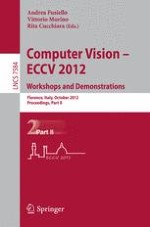The three volume set LNCS 7583, 7584 and 7585 comprises the Workshops and Demonstrations which took place in connection with the European Conference on Computer Vision, ECCV 2012, held in Firenze, Italy, in October 2012. The total of 179 workshop papers and 23 demonstration papers was carefully reviewed and selected for inclusion in the proceedings. They where held at workshops with the following themes: non-rigid shape analysis and deformable image alignment; visual analysis and geo-localization of large-scale imagery; Web-scale vision and social media; video event categorization, tagging and retrieval; re-identification; biological and computer vision interfaces; where computer vision meets art; consumer depth cameras for computer vision; unsolved problems in optical flow and stereo estimation; what's in a face?; color and photometry in computer vision; computer vision in vehicle technology: from earth to mars; parts and attributes; analysis and retrieval of tracked events and motion in imagery streams; action recognition and pose estimation in still images; higher-order models and global constraints in computer vision; information fusion in computer vision for concept recognition; 2.5D sensing technologies in motion: the quest for 3D; benchmarking facial image analysis technologies.
